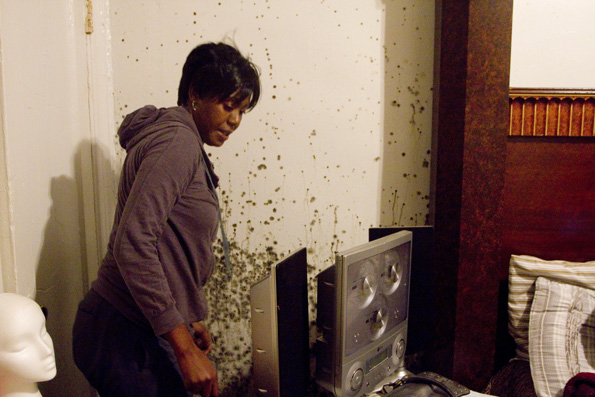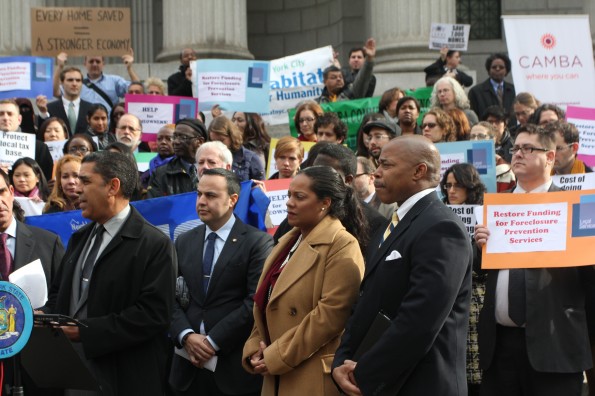
Dyan Kerr deals with a wall of mold in her Williamsbridge apartment. (STEVEN GRABOSKI/The Bronx Ink)
With a single tap of the finger, mailboxes open at 1585 East 172nd Street in Soundview. It’s a trick anyone can pull off.
“Social Security and Section 8 checks have gone missing,” said Andres Rios, the leader of the building’s tenant’s association.
Broken mailboxes are just one problem facing Rios’ building, one of six notoriously distressed buildings in Highbridge, Morris Heights and Soundview. The buildings have been in disrepair since 2006, bouncing from owner to owner, each either without a plan to fix them or the money to carry the plans out.
 The buildings were sold again in September, this time to Bronx real estate agent Anthony Gazivoda, for $21.4 million. Gazivoda paid almost $7 million more than the previous owner, a surprisingly high purchase price that has tenants and housing advocates afraid that the new owner will find himself just as cash-strapped as the previous ones.
The buildings were sold again in September, this time to Bronx real estate agent Anthony Gazivoda, for $21.4 million. Gazivoda paid almost $7 million more than the previous owner, a surprisingly high purchase price that has tenants and housing advocates afraid that the new owner will find himself just as cash-strapped as the previous ones.
“There is no financial story that justifies that sale,” said Dina Levy, executive director of the Urban Housing Assistance Board, the advocacy group that has been following the plight of the buildings. “You can twist it but you still can’t justify it. There’s no amount of rationalization that gets you to $21 million. That’s troubling.”
Anthony Gazivoda did not respond to numerous interview requests.
From the outside, Gazivoda appears to have very few options for turning a profit on the buildings, which house low-income families who cannot afford to pay high rents. Gazivoda is also limited by city regulations, which prevent him from raising many of his tenants’ rents above a small percentage every year.
With no clear profit prospects, tenants and housing advocates are worried that Gazivoda will not have the financial means to make the repairs that are desperately needed. Even worse, they fear that he will stop maintaining the buildings altogether, just like the previous owners.
“I cannot believe we’re here again,” said Levy. “Except this time it’s more money, more money than has ever been put on these buildings.”
The buildings, which sold for $13.5 million in 2010 to previous owner BXP 1 LLC, had 379 violations of the city’s housing code on Dec. 6. The violations range from broken windows and leaky ceilings to padlocked fire exits, entrances that do not lock, and exposed electrical wiring. Four of the buildings have lead-based paint violations.
Anthony Gazivoda is the fourth landlord in the past five years for the six Bronx buildings. The previous three have not been able to improve the dilapidated conditions in the buildings.
The problems are nothing new in the buildings, which have been poorly maintained since the now-defunct Ocelot group purchased them in 2006. After a bitter power struggle left Ocelot without the money to carry out repairs, the group became an absentee landlord, neglecting maintenance until things were so bad that the city took the group to court and ordered them to repair nearly 3,000 violations and pay a $60,000 fine. They were then sold in 2009 to Queens realtor Sam Suzuki of BXP 1 LLC.
Suzuki ended up being no better than Ocelot; under his ownership the buildings racked up over 2,500 housing code violations and two of the Morris Heights buildings made the city’s most distressed list. Angered, the tenants of the Soundview buildings took Suzuki to court where a judge ordered that he make emergency repairs and sentenced him to jail when he failed to do so.
The Manhattan-based Bluestone Group took control of the buildings in June of 2010, promising to make repairs and take a long-term interest in the buildings. Yet Bluestone orchestrated BXP 1’s sale of the buildings to Gazivoda a little over a year later, and angry tenants accused the company of doing just enough to sell the buildings for a profit.
Tenants were initially weary when Gazivoda took over and reported that, like Bluestone before him, Gazivoda asked for a month to begin carrying out repairs. But since then, tenants in the Highbridge and Morris Heights buildings say that security has improved.
“Most of these owners, when they first come here they promise one thing, but then it changes,” tenant Wilfreda Gonzalez said back in September. Gonzalez had high hopes when Gazivoda purchased her building at 1640 Dr. Martin Luther King Blvd. “This owner, at least I can say that he put in the cameras and intercoms.”
But more than a month later, the 11-year resident felt differently about ownership. A leak from the apartment above damaged her bathroom walls last summer, and the tiles have yet to be replaced.
“They’re giving me the runaround,” said Gonzalez, who has called the landlord repeatedly. “He bought the apartment and he has to fix it.”
Gazivoda is both an important and mysterious figure in the Bronx real estate market. The 51-year-old Albanian realtor, who sits on the business development board at Hudson Valley Bank, has been in the real estate business since 1978. Since then, city records show that over 40 real estate companies tied to the Gazivoda family have come share the same 3200 Cruger Ave. address. Altogether, Gazivoda and his family own almost 40 buildings in the Bronx.
| Bronx Albanians move into real estate
Albanians first migrated to America in 1876, according to Constantine Demo, author of The Albanians in America. But they began to move to New York City in big numbers in the 1960s, settling in the Bronx around Morris Park, Arthur Avenue and Pelham Parkway, said Ismer Mjeku, the publisher of the Albanian Yellow Pages, an annual guide for Albanian personal and commercial contacts all across the country. As Albanian immigrants were settling in these Italian enclaves of the Bronx, they concentrated in the food and restaurant industry, which until then had been mainly run by Italian families. Gradually Albanians took over the business and, in the 1980s, displaced many Italian owners from those restaurants.In their pursuit of business diversification, Albanians got into real estate and started amassing properties. According to Mjeku, today the Albanian community owns almost a third of all the apartment buildings in the Bronx, although he said there is no official data to support his claim.The 2011 edition of the Albanian Yellow Pages shows at least 26 Albanian-owned real estate companies operating in the Bronx and Mt. Vernon. -Mahmoud Sabbagh |
Despite owning so much land, very little is known about Gazivoda himself, and the lack of information is worrying to housing advocates. “Who these people are is not clear to us,” said Levy, who has worked at the Urban Housing Assistance Board for seven years. Levy added that Gazivoda “has a very insular network.”
Gazivoda has a mixed record as a landlord. Some of his buildings have no violations, others have as many as 98. And though none of the buildings are as bad as his latest purchases, tenants in his more troubled buildings paint a negative picture of the landlord.
Dyan Kerr lives in one of Gazivoda’s older properties with her family at 678 East 225th St. in Williamsbridge, where violations decreased from 58 to 26 from October to December. Despite the drop in violations, Kerr said she has been dealing with mice and mold for over a year.
“I’m tired of this place,” said Kerr, who has inch-long mold dots clearly visible in her bathroom. Kerr said that management has cleaned the mold in the past, but it kept growing back. In addition, Kerr revealed brown filth in her kitchen cabinet that she said were mice droppings.
“This is how we’re living now because people don’t want to fix nothing,” Kerr said.
Bathroom mold is also a problem a few miles away in Belmont, where Shantelle Guzman lives in another of Gazivoda’s older properties.
“They paint over the mold and the super doesn’t fix anything, he doesn’t live here,” said Guzman, who lives at 611 East 182nd St.
Guzman’s apartment also has holes in the walls, where she said mice enter her one-bedroom apartment. She is also upset about shoddy heating that forces her and other residents to use their ovens for heat and an irregular flow of hot water in the building and would like to leave.
Back in Soundview, moving has never been an option for Rios, who has led his tenant’s association through five different landlords in 14 years. If necessary, Rios is gearing up for the next battle.
“I like to bark and bite,” said Rios, who showed Gazivoda the faulty mailboxes in front of a group of tenants at a meeting on Nov. 9. Before exiting, Gazivoda assured his tenants that the mailbox problem, as well as the dysfunctional fire alarms, would be addressed.
“He said it would be taken care of but that it’s not going to be done quick,” he added, discouraged. “I guess to them it wasn’t a priority.”













